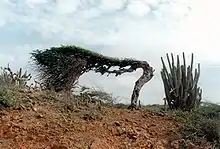Libidibia coriaria
Libidibia coriaria is a leguminous tree or large shrub native to the Caribbean, Mexico, Central America, and northern South America. Common names include Divi-divi, Cascalote, Guaracabuya, Guatapana, Nacascol,[1] and Watapana (Aruba).
| Libidibia coriaria | |
|---|---|
 | |
| Divi-divi on Aruba | |
| Scientific classification | |
| Kingdom: | |
| (unranked): | |
| (unranked): | |
| (unranked): | |
| Order: | |
| Family: | |
| Genus: | |
| Species: | L. coriaria |
| Binomial name | |
| Libidibia coriaria (Jacq. 1763) Schltdl. 1830 | |
| Synonyms[1] | |
| |
Description

L. coriaria rarely reaches its maximum height of 9 m (30 ft) because its growth is contorted by the trade winds that batter the exposed coastal sites where it often grows. In other environments it grows into a low dome shape with a clear sub canopy space. Leaves are bipinnate, with 5–10 pairs of pinnae, each pinna with 15–25 pairs of leaflets; the individual leaflets are 7 mm long and 2 mm broad. The fruit is a twisted pod 5 cm (2.0 in) long.
The Divi-divi is one of the more well known species of Libidibia; it is the national tree of Curaçao.[2] It is also very common and popular on Aruba.

Chemistry
Tannins are extracted from Divi-divi pods for use in leather production.[3][4]
Among the molecules isolated is corilagin, whose name comes from the specific epithet of the plant.
References
- "Caesalpinia coriaria". Germplasm Resources Information Network (GRIN). Agricultural Research Service (ARS), United States Department of Agriculture (USDA). Retrieved 2011-04-18.
- Sullivan, Lynne M. (2006). Adventure Guide to Aruba, Bonaire & Curaçao. Hunter Publishing Inc. p. 10. ISBN 978-1-58843-572-9.
- "Vegetable tannins". Bookbinding and the Conservation of Books. Conservation OnLine. 2011-03-10. Retrieved 2011-04-18.
- Perez-Tello, Carlos (1995). "Recovery of Vegetable Tannins from Divi-divi Pods". Journal of Chemical Technology & Biotechnology. 64 (1): 101–104. doi:10.1002/jctb.280640116.
External links
 Media related to Libidibia coriaria at Wikimedia Commons
Media related to Libidibia coriaria at Wikimedia Commons Data related to Libidibia coriaria at Wikispecies
Data related to Libidibia coriaria at Wikispecies
